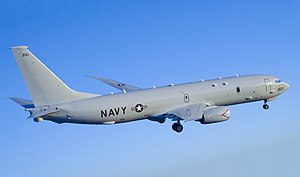
The Boeing P-8 Poseidon (formerly the Multimission Maritime Aircraft or MMA) is a military aircraft developed for the United States Navy (USN). The aircraft has been developed by Boeing Defense, Space & Security, modified from the 737-800ERX.
The P-8 conducts anti-submarine warfare (ASW), anti-surface warfare (ASUW), and shipping interdiction, along with an electronic signals intelligence (ELINT) role. This involves carrying torpedoes, depth charges, SLAM-ER missiles, Harpoon anti-ship missiles, and other weapons. It is able to drop and monitor sonobuoys. It is designed to operate in conjunction with the Northrop Grumman MQ-4C Triton Broad Area Maritime Surveillance unmanned aerial vehicle. The aircraft has been ordered by the Indian Navy as the P-8I Neptune, and the Royal Australian Air Force.
The Lockheed P-3 Orion, a turboprop ASW aircraft, has been in service with the United States Navy since 1962. In the 1980s, the Navy began studies for a P-3 replacement, the range and endurance of which was reducing due to increasing weight and airframe fatigue life limitations. The specification required a new aircraft to have reduced operating and support costs. In 1989, the Navy awarded Lockheed a fixed-price contract to develop the P-7, but this was canceled the following year. A second competition for a replacement began in 2000. Lockheed Martin submitted the Orion 21, an updated new-build version of the P-3. Boeing's proposal was based on its 737-800 airliner. BAE Systems offered a new-build version of the Nimrod MRA4, a British jet-powered maritime patrol aircraft. BAE withdrew from the competition in October 2002, recognizing that without a production partner based in the United States, the bid was politically unrealistic. On 14 May 2004, Boeing was selected as the winner.
In June 2004, the U.S. Navy awarded a development contract to Boeing. The project was planned to be for at least 108 airframes for the Navy. More orders are possible from the other nations operating over 200 P-3s. Project value is expected to be worth at least $15 billion. Raytheon, Northrop Grumman, Spirit AeroSystems, GE Aviation Systems, Marshall Aerospace and Defence Group, CFMI, BAE Systems, and Marotta are major subcontractors. In July 2004, the Navy placed an order for five MMA aircraft, and the first flight-test aircraft was to be completed in 2009. On 30 March 2005, the P-8A designation was assigned to the aircraft.
The P-8 is a militarized version of the Boeing 737-800 with 737-900-based wings. The fuselage is similar, but longer, than the 737-700-based C-40 Clipper transport aircraft in service with the U.S. Navy. The P-8 has a strengthened fuselage and Boeing 767-400ER-style raked wingtips, instead of the blended winglets available on 737NG variants. In order to power additional onboard electronics, the P-8 has a 180kVA electric generator on each engine, replacing the 90kVA generator of civilian 737s; this required the redesigning of the nacelles and their wing mountings. The P-8 has a smoother flight experience, subjecting crews to less turbulence and fumes than the preceding P-3, allowing them to focus better on missions.
The five operator stations (two naval flight officers plus three enlisted Aviation Warfare Operators/naval aircrewman) are mounted in a sideways row, along the port side of the cabin. None of the crew stations have windows; a single observer window is located on each side of the forward cabin. A short bomb bay for torpedoes and other stores opens behind the wing. The P-8 is to be equipped with the High Altitude Anti-Submarine Warfare Weapon Capability (HAAWC) Air Launch Accessory (ALA), turning a Mark 54 torpedo into a glide bomb for deploying from up to 30,000 ft (9,100 m).
The P-8 features the Raytheon APY-10 multi-mission surface search radar; the P-8I features an international version of the APY-10. Unlike the preceding P-3, the P-8 lacks a magnetic anomaly detector (MAD) due to its higher operational altitude; its acoustic sensor system is reportedly more effective at acoustic tracking and thus lacking a MAD won't impede its detection capabilities; the P-8I is equipped with a MAD per the contract request. Various sensor data are combined via data fusion software to track targets. Following the cancellation of Lockheed Martin's Aerial Common Sensor project, Boeing proposed a signals intelligence variant of the P-8 for the Navy's requirement. During the P-8A Increment 2 upgrade in 2016, the APS-149 Littoral Surveillance Radar System (LSRS) will be replaced by the Advanced Airborne Sensor radar.
In U.S. service, the P-8 fleet will be complemented by around 40 Northrop Grumman MQ-4C Triton unmanned aerial vehicles (UAVs) for the Broad Area Maritime Surveillance system to provide continuous surveillance. In January 2015, BAE Systems was awarded a contract for the Navy's High Altitude ASW (HAASW) Unmanned Targeting Air System (UTAS) program to develop a sub-hunting UAV equipped with a MAD for launching from the P-8. The P-8 cannot use the Navy's typical hose-and-drogue in-flight refueling method, instead featuring a flying boom receptacle on the upper-forward fuselage. For extended endurance, six additional fuel tanks from Marshall Aerospace are housed in the forward and rear cargo compartments.
No comments:
Post a Comment